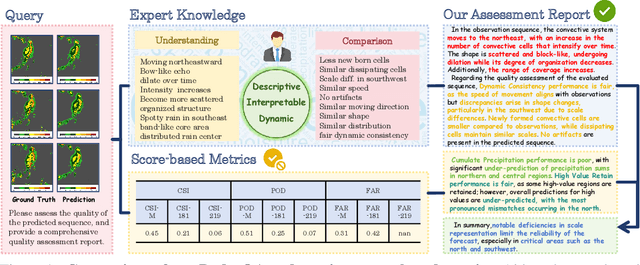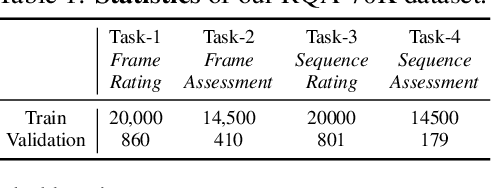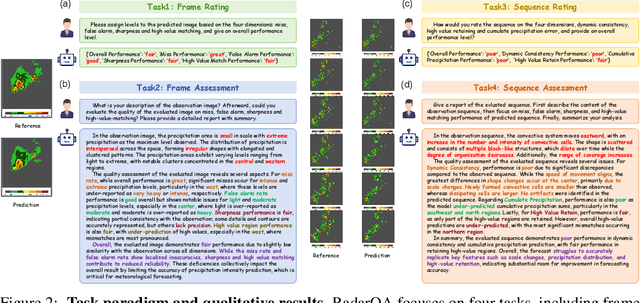Junchao Gong
RadarQA: Multi-modal Quality Analysis of Weather Radar Forecasts
Aug 17, 2025



Abstract:Quality analysis of weather forecasts is an essential topic in meteorology. Although traditional score-based evaluation metrics can quantify certain forecast errors, they are still far from meteorological experts in terms of descriptive capability, interpretability, and understanding of dynamic evolution. With the rapid development of Multi-modal Large Language Models (MLLMs), these models become potential tools to overcome the above challenges. In this work, we introduce an MLLM-based weather forecast analysis method, RadarQA, integrating key physical attributes with detailed assessment reports. We introduce a novel and comprehensive task paradigm for multi-modal quality analysis, encompassing both single frame and sequence, under both rating and assessment scenarios. To support training and benchmarking, we design a hybrid annotation pipeline that combines human expert labeling with automated heuristics. With such an annotation method, we construct RQA-70K, a large-scale dataset with varying difficulty levels for radar forecast quality evaluation. We further design a multi-stage training strategy that iteratively improves model performance at each stage. Extensive experiments show that RadarQA outperforms existing general MLLMs across all evaluation settings, highlighting its potential for advancing quality analysis in weather prediction.
Align-DA: Align Score-based Atmospheric Data Assimilation with Multiple Preferences
May 28, 2025Abstract:Data assimilation (DA) aims to estimate the full state of a dynamical system by combining partial and noisy observations with a prior model forecast, commonly referred to as the background. In atmospheric applications, this problem is fundamentally ill-posed due to the sparsity of observations relative to the high-dimensional state space. Traditional methods address this challenge by simplifying background priors to regularize the solution, which are empirical and require continual tuning for application. Inspired by alignment techniques in text-to-image diffusion models, we propose Align-DA, which formulates DA as a generative process and uses reward signals to guide background priors, replacing manual tuning with data-driven alignment. Specifically, we train a score-based model in the latent space to approximate the background-conditioned prior, and align it using three complementary reward signals for DA: (1) assimilation accuracy, (2) forecast skill initialized from the assimilated state, and (3) physical adherence of the analysis fields. Experiments with multiple reward signals demonstrate consistent improvements in analysis quality across different evaluation metrics and observation-guidance strategies. These results show that preference alignment, implemented as a soft constraint, can automatically adapt complex background priors tailored to DA, offering a promising new direction for advancing the field.
Transforming Weather Data from Pixel to Latent Space
Mar 09, 2025Abstract:The increasing impact of climate change and extreme weather events has spurred growing interest in deep learning for weather research. However, existing studies often rely on weather data in pixel space, which presents several challenges such as smooth outputs in model outputs, limited applicability to a single pressure-variable subset (PVS), and high data storage and computational costs. To address these challenges, we propose a novel Weather Latent Autoencoder (WLA) that transforms weather data from pixel space to latent space, enabling efficient weather task modeling. By decoupling weather reconstruction from downstream tasks, WLA improves the accuracy and sharpness of weather task model results. The incorporated Pressure-Variable Unified Module transforms multiple PVS into a unified representation, enhancing the adaptability of the model in multiple weather scenarios. Furthermore, weather tasks can be performed in a low-storage latent space of WLA rather than a high-storage pixel space, thus significantly reducing data storage and computational costs. Through extensive experimentation, we demonstrate its superior compression and reconstruction performance, enabling the creation of the ERA5-latent dataset with unified representations of multiple PVS from ERA5 data. The compressed full PVS in the ERA5-latent dataset reduces the original 244.34 TB of data to 0.43 TB. The downstream task further demonstrates that task models can apply to multiple PVS with low data costs in latent space and achieve superior performance compared to models in pixel space. Code, ERA5-latent data, and pre-trained models are available at https://anonymous.4open.science/r/Weather-Latent-Autoencoder-8467.
WeatherGFM: Learning A Weather Generalist Foundation Model via In-context Learning
Nov 08, 2024



Abstract:The Earth's weather system encompasses intricate weather data modalities and diverse weather understanding tasks, which hold significant value to human life. Existing data-driven models focus on single weather understanding tasks (e.g., weather forecasting). Although these models have achieved promising results, they fail to tackle various complex tasks within a single and unified model. Moreover, the paradigm that relies on limited real observations for a single scenario hinders the model's performance upper bound. In response to these limitations, we draw inspiration from the in-context learning paradigm employed in state-of-the-art visual foundation models and large language models. In this paper, we introduce the first generalist weather foundation model (WeatherGFM), designed to address a wide spectrum of weather understanding tasks in a unified manner. More specifically, we initially unify the representation and definition of the diverse weather understanding tasks. Subsequently, we devised weather prompt formats to manage different weather data modalities, namely single, multiple, and temporal modalities. Finally, we adopt a visual prompting question-answering paradigm for the training of unified weather understanding tasks. Extensive experiments indicate that our WeatherGFM can effectively handle up to ten weather understanding tasks, including weather forecasting, super-resolution, weather image translation, and post-processing. Our method also showcases generalization ability on unseen tasks.
PostCast: Generalizable Postprocessing for Precipitation Nowcasting via Unsupervised Blurriness Modeling
Oct 08, 2024



Abstract:Precipitation nowcasting plays a pivotal role in socioeconomic sectors, especially in severe convective weather warnings. Although notable progress has been achieved by approaches mining the spatiotemporal correlations with deep learning, these methods still suffer severe blurriness as the lead time increases, which hampers accurate predictions for extreme precipitation. To alleviate blurriness, researchers explore generative methods conditioned on blurry predictions. However, the pairs of blurry predictions and corresponding ground truth need to be generated in advance, making the training pipeline cumbersome and limiting the generality of generative models within blur modes that appear in training data. By rethinking the blurriness in precipitation nowcasting as a blur kernel acting on predictions, we propose an unsupervised postprocessing method to eliminate the blurriness without the requirement of training with the pairs of blurry predictions and corresponding ground truth. Specifically, we utilize blurry predictions to guide the generation process of a pre-trained unconditional denoising diffusion probabilistic model (DDPM) to obtain high-fidelity predictions with eliminated blurriness. A zero-shot blur kernel estimation mechanism and an auto-scale denoise guidance strategy are introduced to adapt the unconditional DDPM to any blurriness modes varying from datasets and lead times in precipitation nowcasting. Extensive experiments are conducted on 7 precipitation radar datasets, demonstrating the generality and superiority of our method.
WeatherFormer: Empowering Global Numerical Weather Forecasting with Space-Time Transformer
Sep 21, 2024Abstract:Numerical Weather Prediction (NWP) system is an infrastructure that exerts considerable impacts on modern society.Traditional NWP system, however, resolves it by solving complex partial differential equations with a huge computing cluster, resulting in tons of carbon emission. Exploring efficient and eco-friendly solutions for NWP attracts interest from Artificial Intelligence (AI) and earth science communities. To narrow the performance gap between the AI-based methods and physic predictor, this work proposes a new transformer-based NWP framework, termed as WeatherFormer, to model the complex spatio-temporal atmosphere dynamics and empowering the capability of data-driven NWP. WeatherFormer innovatively introduces the space-time factorized transformer blocks to decrease the parameters and memory consumption, in which Position-aware Adaptive Fourier Neural Operator (PAFNO) is proposed for location sensible token mixing. Besides, two data augmentation strategies are utilized to boost the performance and decrease training consumption. Extensive experiments on WeatherBench dataset show WeatherFormer achieves superior performance over existing deep learning methods and further approaches the most advanced physical model.
CasCast: Skillful High-resolution Precipitation Nowcasting via Cascaded Modelling
Feb 06, 2024



Abstract:Precipitation nowcasting based on radar data plays a crucial role in extreme weather prediction and has broad implications for disaster management. Despite progresses have been made based on deep learning, two key challenges of precipitation nowcasting are not well-solved: (i) the modeling of complex precipitation system evolutions with different scales, and (ii) accurate forecasts for extreme precipitation. In this work, we propose CasCast, a cascaded framework composed of a deterministic and a probabilistic part to decouple the predictions for mesoscale precipitation distributions and small-scale patterns. Then, we explore training the cascaded framework at the high resolution and conducting the probabilistic modeling in a low dimensional latent space with a frame-wise-guided diffusion transformer for enhancing the optimization of extreme events while reducing computational costs. Extensive experiments on three benchmark radar precipitation datasets show that CasCast achieves competitive performance. Especially, CasCast significantly surpasses the baseline (up to +91.8%) for regional extreme-precipitation nowcasting.
FengWu-GHR: Learning the Kilometer-scale Medium-range Global Weather Forecasting
Jan 28, 2024Abstract:Kilometer-scale modeling of global atmosphere dynamics enables fine-grained weather forecasting and decreases the risk of disastrous weather and climate activity. Therefore, building a kilometer-scale global forecast model is a persistent pursuit in the meteorology domain. Active international efforts have been made in past decades to improve the spatial resolution of numerical weather models. Nonetheless, developing the higher resolution numerical model remains a long-standing challenge due to the substantial consumption of computational resources. Recent advances in data-driven global weather forecasting models utilize reanalysis data for model training and have demonstrated comparable or even higher forecasting skills than numerical models. However, they are all limited by the resolution of reanalysis data and incapable of generating higher-resolution forecasts. This work presents FengWu-GHR, the first data-driven global weather forecasting model running at the 0.09$^{\circ}$ horizontal resolution. FengWu-GHR introduces a novel approach that opens the door for operating ML-based high-resolution forecasts by inheriting prior knowledge from a pretrained low-resolution model. The hindcast of weather prediction in 2022 indicates that FengWu-GHR is superior to the IFS-HRES. Furthermore, evaluations on station observations and case studies of extreme events support the competitive operational forecasting skill of FengWu-GHR at the high resolution.
FengWu: Pushing the Skillful Global Medium-range Weather Forecast beyond 10 Days Lead
Apr 06, 2023



Abstract:We present FengWu, an advanced data-driven global medium-range weather forecast system based on Artificial Intelligence (AI). Different from existing data-driven weather forecast methods, FengWu solves the medium-range forecast problem from a multi-modal and multi-task perspective. Specifically, a deep learning architecture equipped with model-specific encoder-decoders and cross-modal fusion Transformer is elaborately designed, which is learned under the supervision of an uncertainty loss to balance the optimization of different predictors in a region-adaptive manner. Besides this, a replay buffer mechanism is introduced to improve medium-range forecast performance. With 39-year data training based on the ERA5 reanalysis, FengWu is able to accurately reproduce the atmospheric dynamics and predict the future land and atmosphere states at 37 vertical levels on a 0.25{\deg} latitude-longitude resolution. Hindcasts of 6-hourly weather in 2018 based on ERA5 demonstrate that FengWu performs better than GraphCast in predicting 80\% of the 880 reported predictands, e.g., reducing the root mean square error (RMSE) of 10-day lead global z500 prediction from 733 to 651 $m^{2}/s^2$. In addition, the inference cost of each iteration is merely 600ms on NVIDIA Tesla A100 hardware. The results suggest that FengWu can significantly improve the forecast skill and extend the skillful global medium-range weather forecast out to 10.75 days lead (with ACC of z500 > 0.6) for the first time.
 Add to Chrome
Add to Chrome Add to Firefox
Add to Firefox Add to Edge
Add to Edge